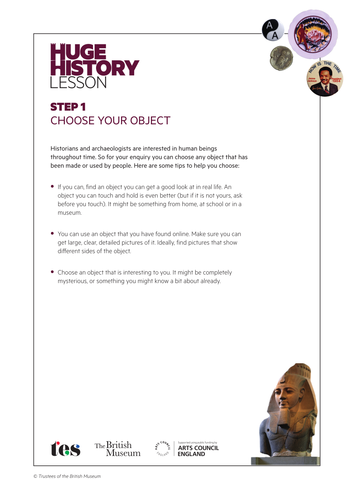
The Huge History Lesson competition (tes.com/hugehistory) has launched and we would love for you and your class to get involved. To help you get started, we’ve put together a step-by-step guide for students to explain the process behind successfully completing an historical enquiry.
For ideas on how to incorporate the competition into your teaching, see our blog posts with inspiration for primary teachers (https://www.tes.com/teaching-resources/blog/huge-history-lesson-teaching-ideas-primary) and secondary teachers (https://www.tes.com/teaching-resources/blog/huge-history-lesson-teaching-ideas-secondary).
Find more inspiration for this object-led enquiry competition via the Teaching history with 100 objects website (http://teachinghistory100.org/) and if you have any questions about the competition, or how to tackle object-led historical enquiry, do get in touch via help@tesglobal.com
Introduction for students:
The following guide will give you some ideas for investigating museum objects and using them for an historical enquiry. It will help you think like historians and archaeologists, who use clues to find out about people in the past. It is a step-by-step guide, but you do not have to answer all the questions or even follow all the steps in order. You might have your own ideas about how to find clues and use them to find out about the past.
For ideas on how to incorporate the competition into your teaching, see our blog posts with inspiration for primary teachers (https://www.tes.com/teaching-resources/blog/huge-history-lesson-teaching-ideas-primary) and secondary teachers (https://www.tes.com/teaching-resources/blog/huge-history-lesson-teaching-ideas-secondary).
Find more inspiration for this object-led enquiry competition via the Teaching history with 100 objects website (http://teachinghistory100.org/) and if you have any questions about the competition, or how to tackle object-led historical enquiry, do get in touch via help@tesglobal.com
Introduction for students:
The following guide will give you some ideas for investigating museum objects and using them for an historical enquiry. It will help you think like historians and archaeologists, who use clues to find out about people in the past. It is a step-by-step guide, but you do not have to answer all the questions or even follow all the steps in order. You might have your own ideas about how to find clues and use them to find out about the past.
Something went wrong, please try again later.
I am very excited by this resource and plan to use it to enthuse observational skills in history.
Report this resourceto let us know if it violates our terms and conditions.
Our customer service team will review your report and will be in touch.
£0.00
